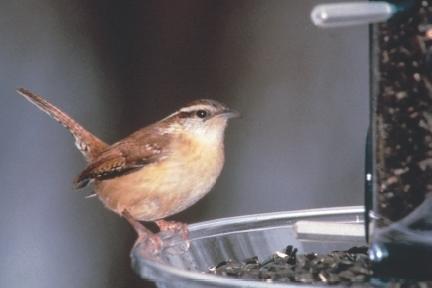Wrens
Fun Facts About Wrens
- You can increase your chances of attracting Carolina Wrens to you feeders by providing a brush pile close to your feeding area. They feel more secure with a place to seek refuge nearby.
- A single male Carolina Wren can sing up to forty different songs – up to 3,000 times in a single day
- A female Carolina Wren is unable to defend her territory alone if her mate dies, so she spends much of her time watching for predators as they forage together.
- Unlike other wren species, only the male Carolina Wren sings the loud song.
- One captive male Carolina Wren sang nearly 3,000 times in a single day.
- A pair bond may form between a male and a female Carolina Wren at any time of the year, and the pair will stay together for life. Members of a pair stay together on their territory year-round, and forage and move around the territory together
- Breeding from Canada southward to the southern tip of South America, the House Wren has one of the largest ranges of any bird found in the New World.
- A male House Wren may lay claim to a nesting cavity by filling it with more than 400 small twigs. If the female likes what she sees, she will then take over, adding the nest cup and lining it with grass, inner bark, hair, and feathers.
- The stick filled cavity of the House Wren nest provides “stilts” for the nest cup which allows rainwater to collect in the bottom of the nesting cavity without endangering the eggs or young.
- House Wrens are known for destroying the eggs or young of other birds nesting within 100 feet of their own nest. In some areas, this is the primary source of nesting failure for Prothonotary Warblers, Tree Swallows, chickadees, and bluebirds.
- Bewick's Wren populations have declined sharply in the eastern United States. The declines appear most likely due to competition from the nest-destroying House Wren whose range expansion has accompanied the loss of the Bewick’s Wren.
- Audubon first identified the Bewick’s Wren in 1821 while in Louisiana. He named it for his friend, Thomas Bewick, a British engraver.
- In proportion to its size and weight, the call of the Winter Wren is 10 times louder than that of a crowing rooster.
- On average, Winter Wrens sing between 16 - 36 notes per second.
- Out of 78 species of wrens found in the New World, the Winter Wren is the only one to take up residence outside of the Americas.


